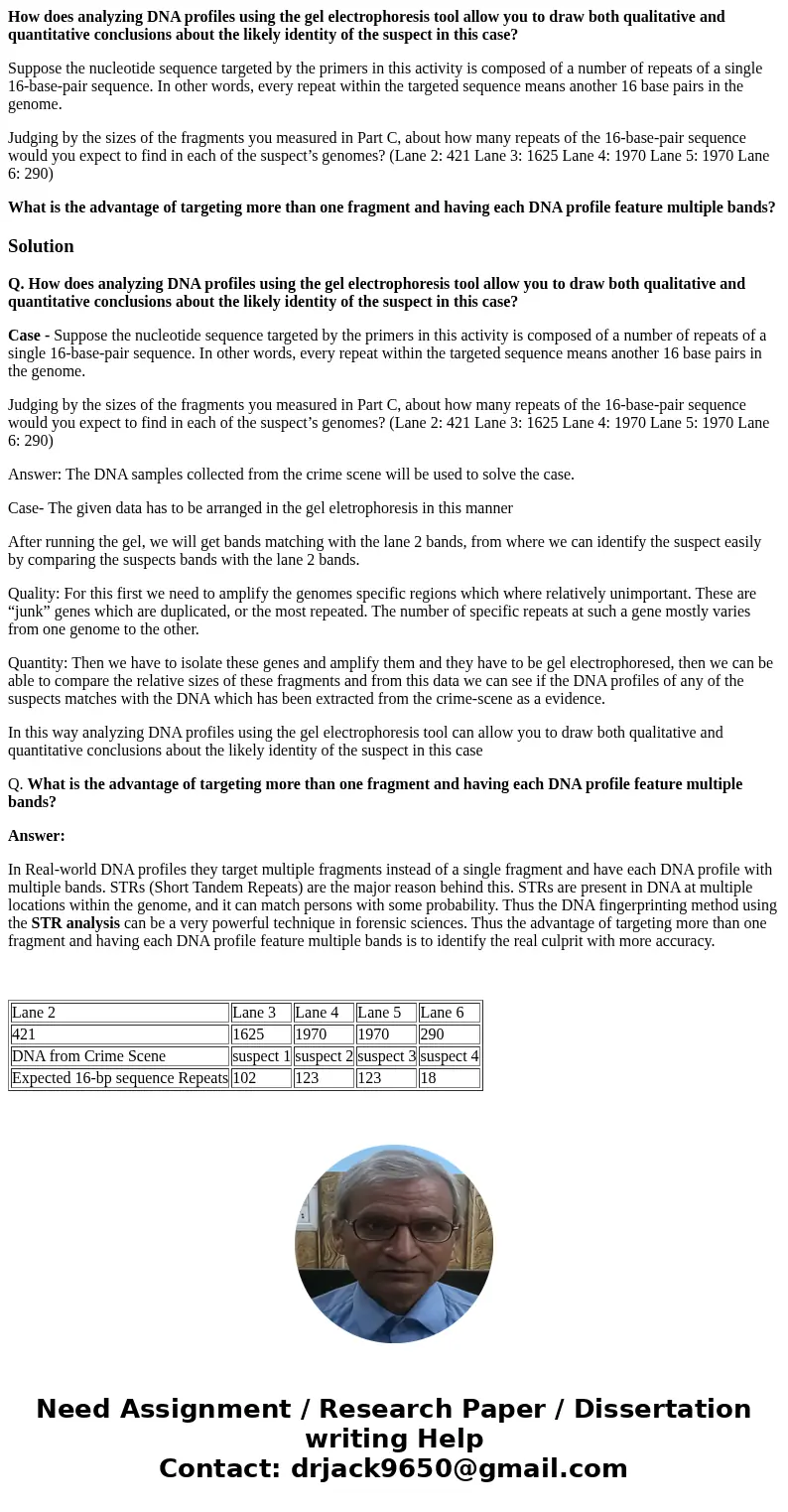How does analyzing DNA profiles using the gel electrophoresi
How does analyzing DNA profiles using the gel electrophoresis tool allow you to draw both qualitative and quantitative conclusions about the likely identity of the suspect in this case?
Suppose the nucleotide sequence targeted by the primers in this activity is composed of a number of repeats of a single 16-base-pair sequence. In other words, every repeat within the targeted sequence means another 16 base pairs in the genome.
Judging by the sizes of the fragments you measured in Part C, about how many repeats of the 16-base-pair sequence would you expect to find in each of the suspect’s genomes? (Lane 2: 421 Lane 3: 1625 Lane 4: 1970 Lane 5: 1970 Lane 6: 290)
What is the advantage of targeting more than one fragment and having each DNA profile feature multiple bands?
Solution
Q. How does analyzing DNA profiles using the gel electrophoresis tool allow you to draw both qualitative and quantitative conclusions about the likely identity of the suspect in this case?
Case - Suppose the nucleotide sequence targeted by the primers in this activity is composed of a number of repeats of a single 16-base-pair sequence. In other words, every repeat within the targeted sequence means another 16 base pairs in the genome.
Judging by the sizes of the fragments you measured in Part C, about how many repeats of the 16-base-pair sequence would you expect to find in each of the suspect’s genomes? (Lane 2: 421 Lane 3: 1625 Lane 4: 1970 Lane 5: 1970 Lane 6: 290)
Answer: The DNA samples collected from the crime scene will be used to solve the case.
Case- The given data has to be arranged in the gel eletrophoresis in this manner
After running the gel, we will get bands matching with the lane 2 bands, from where we can identify the suspect easily by comparing the suspects bands with the lane 2 bands.
Quality: For this first we need to amplify the genomes specific regions which where relatively unimportant. These are “junk” genes which are duplicated, or the most repeated. The number of specific repeats at such a gene mostly varies from one genome to the other.
Quantity: Then we have to isolate these genes and amplify them and they have to be gel electrophoresed, then we can be able to compare the relative sizes of these fragments and from this data we can see if the DNA profiles of any of the suspects matches with the DNA which has been extracted from the crime-scene as a evidence.
In this way analyzing DNA profiles using the gel electrophoresis tool can allow you to draw both qualitative and quantitative conclusions about the likely identity of the suspect in this case
Q. What is the advantage of targeting more than one fragment and having each DNA profile feature multiple bands?
Answer:
In Real-world DNA profiles they target multiple fragments instead of a single fragment and have each DNA profile with multiple bands. STRs (Short Tandem Repeats) are the major reason behind this. STRs are present in DNA at multiple locations within the genome, and it can match persons with some probability. Thus the DNA fingerprinting method using the STR analysis can be a very powerful technique in forensic sciences. Thus the advantage of targeting more than one fragment and having each DNA profile feature multiple bands is to identify the real culprit with more accuracy.
| Lane 2 | Lane 3 | Lane 4 | Lane 5 | Lane 6 |
| 421 | 1625 | 1970 | 1970 | 290 |
| DNA from Crime Scene | suspect 1 | suspect 2 | suspect 3 | suspect 4 |
| Expected 16-bp sequence Repeats | 102 | 123 | 123 | 18 |

 Homework Sourse
Homework Sourse